A.J.S. Rayl • Dec 03, 2015
Mars Exploration Rovers Update: Reality Bites but Opportunity Climbs to "Treasure Trove"
Sols 4183–4213
Opportunity faced the challenges of winter as well as technological issues in November, but the Mars Exploration Rover pressed on, hiking up hill and into a geological treasure trove that may well present the scientists with the evidence they need to solve the clay mineral mystery of Marathon Valley.
The veteran solar-powered robot field geologist had been conducting a "walkabout" or scientific survey of Marathon Valley since late July. In addition to looking for clay minerals the MER team knows are there, Opportunity was also working her way around the valley to the southern side where she could position herself on north-facing slopes to take in as much sunlight as possible during the mission’s seventh Martian winter.
"We are done with our walkabout for now," said Steve Squyres, MER principal investigator, of Cornell University. "The key [in November] was really climbing up onto this steep slope and into this area where we see more of this weird red banding.”
The rover found outcrops characterized by the intriguing red swirling bands on the floor of the valley, but the “red rocks” were “crumbly” and contaminated with dirt that could have blown in from miles away. All the dirt was making it difficult for the scientists to determine if in fact the rocks in the so-called red zones were harboring the ancient clay minerals. Given the rover's new "treasure trove" site however, that may well change soon.
"This area along the valley southern wall, because it’s so well exposed, is going to be the 'gold mine,' so to speak, that will help us understand what’s carrying the clay minerals,” said Ray Arvidson, MER deputy principal investigator, of Washington University St. Louis (WUSTL).
Marathon Valley, which cuts the western rim of Endeavour Crater, had become a high priority destination back in 2009. That's when the Compact Reconnaissance Imaging Spectrometer for Mars (CRISM), onboard the Mars Reconnaissance Orbiter (MRO), detected a mother lode of phyllosilicates there, specifically smectite clay minerals, evidence of fresh or near neutral water in the distant past.
Arvidson, who is also a co-investigator on CRISM, and his students at WUSTL have been refining the analysis of the orbital data. They are now working to complete a detailed map that is showing the intricate patterns of red banding and swirls correlate with where CRISM detected the signatures for clay minerals.
"We have found with certainty now that the areas that show the phyllosilicate signatures in the orbital data are the same areas that are characterized by the weird red banding that we see here,” said Squyres. “There is a one-to-one correlation between where the red zones are and the phyllosilicate signatures are.”
“Red zones can be in what appear to be swirls in outcrops on the floor, in linear veins, and maybe even as layers in strata,” elaborated Arvidson.
The MER scientists are confident the so-called red zones have a lot to say about the Endeavour’s past watery environment. "The red rocks, we know, are high aluminum and silicon and low iron and manganese, and they have hematite as a signature from the Panoramic Camera (Pancam), so they seem to altered and leeched," said Arvidson. "They might be carrying the smectite signature we see from orbit."
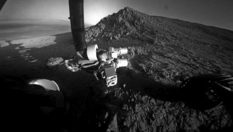
On top of the Martian world
Just after arrival at a site named Private Isaac White in Mid-November 2015, Opportunity used her Navigation Camera (Navcam) to take the images that went into this panorama processed by Stuart Atkinson, MER poet, author, and an image contributor to the MER Update. The site is up on a steep slope on Marathon Valley's southern wall. Check out the rover's shadow on the left. For more of Atkinson's work, visit his: The Road to Endeavour.NASA / JPL-Caltech / S. Atkinson
Since Opportunity’s two mineral detectors are no longer working, the team's objective in Marathon Valley is to study the context for outcrops bearing clay minerals and neighboring deposits, just as it did at Matijevic Hill in 2013 when it made history as the first mission to groundtruth phyllosilicates on Mars.
Endeavour dates back to the Noachian Period 3 to 4 billion years ago, a time when most planetary scientists believe that Mars was more like Earth. MER is the only ground mission so far to investigate Martian territory this ancient and the research in Marathon Valley will no doubt expand the story of water and environmental changes there.
As November began, Opportunity was positioned over the fourth and final target in the first science investigation at the valley's southern end, an outcrop the team named after Private Ebenezer Tuttle, a member of the Corps of Discovery, more popularly known as the Lewis & Clark expedition. Like the previous three targets in that mini-science campaign, which the robot examined in October, Pvt. Tuttle was "representative of rocks and materials on the lower part of the south wall," said Arvidson.
The science plan was for Opportunity to work on determining the chemistry of Pvt. Tuttle and keep an eye on the dust. But the robot’s primary focus for the first two weeks of the month was to work with her software engineers on testing the usability of her errant flash drive and sending home images and data collected in October and still stored in her non-volatile or long-term memory. That data included Pancam images of Marathon Valley’s floor and southern wall.
Opportunity succeeded in sending home many of the Pancam images, but not all the data stored in flash. Although the rover suffered two sudden, unexpected reboots, it was the number of "amnesia" events – where the rover fails to boot into or wake-up in flash and winds up in RAM mode – that stymied the plan.
When operating in RAM [random access memory] mode, the rover must uplink all her work to one of the orbiters each sol before she goes to sleep, because it is volatile memory that does not retain data once the rover shuts down to sleep, unlike flash, which is non-volatile memory and does retain data indefinitely.
"We still want to do some analysis and we want to get the rest of the science data down, so we want more time in flash, but we've put it off because we're going into winter and lower power and temperatures," said John Callas, MER project manager of the Jet Propulsion Laboratory (JPL), home to all NASA's Mars rovers. “We didn't want to do anything that added any risk to the rover at this time.”
Whether Opportunity will be able to make any effective use of flash in the future remains to be seen. "That's the question we're trying to answer and we can't answer that yet," said Callas.
Flash or no flash, the veteran robot would rove on. "We have said we still have mission in RAM mode and we're proving that to be the case," said Bill Nelson, chief of MER engineering at JPL.
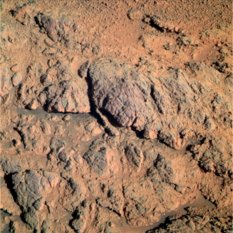
A geological treasure trove
Opportunity took this image of Pvt. White site with her Pancam in late November 2015. MER Deputy Principal Investigator Ray Arvidson described the site as "a treasure trove of geological information." This image was processed by James Canvin, a meteorologist, data scientist, self-described rover hugger, and Planetary Society contributor. It shows the rover's workplane and the Pvt. Hugh McNeal target the rover was checking out upclose at month's end. Canvin's latest images from Opportunity and Marathon Valley, can be found here.NASA / JPL-Caltech / Cornell / ASU / J. Canvin
On Monday, November 16th, the scientists made the call to carry on. "We said: ‘This is enough. Winter’s a’coming and we need to get moving,’" Arvidson recounted saying at the end of sol (EOS) meeting.
So the next sol or Martian day [on Sol 4200 (November 17, 2015)], Opportunity woke up in RAM mode and took off, climbing up and onto a northerly slope on the valley’s southern wall. When the drive was over, the rover was angled at about 20 degrees toward the Sun and sitting in an expanse of layered and fractured outcrops, some rich with deep red banding.
As excited as the scientists are about the new digs – promptly named Private Isaac White after another member of the Lewis & Clark expedition – the engineers are excited by the tilt. "The energy jumped by 40 watt-hours, from the 340's to 381 watt-hours,” said Jennifer Herman, MER's power team lead. That's more than one-third the power producing capability the rover had on landing 11 years and 10 months ago. And it's better than the original winter projections.
While Opportunity is not "officially" in winter, the rover is in “the low energy time of year,” Herman said. Predicting the arrival of Martian winters in terms of impact on the rover is "tricky." Consider that winter solstice in the southern hemisphere of Mars is January 3, 2016, technically the first Martian day of winter. "But winter solstice is not the minimum energy day,” she pointed out. Since Mars' orbit is more eccentric compared to Earth’s orbit, aphelion (the Martian day or sol when Mars is farthest from the Sun in its orbit) was actually Saturday, November 21st.
Although Mars is now orbiting nearer to the Sun in orbit, "the planet is also tilting away from the Sun," noted Herman. Therefore, the sol of minimum solar energy – known as insolation and defined by how many watts per square meter are hitting the top of the atmosphere on Mars – is December 14th. "It's going to get a little bit worse until then, but after December 14th, it will start to get a little bit better and we'll start coming out of it," she said.
"This winter may be a lot easier on us than we originally predicted," summed up Nelson.
Opportunity will spend the Martian winter, which lasts about twice as long as winter on Earth, studying and exploring the valley's southern wall. "We’re going to ‘slide’ laterally along the wall as the winter science campaign progresses, because that’s where all the beautiful red rocks and dark rocks are exposed," said Arvidson.
Spirit and Opportunity landed on Mars in 2004 to begin missions originally planned to last three months. Both rovers far exceeded those plans and each made discoveries about ancient wet environments on Mars. Spirit gave it her all working in the harsh, rocky environs of Gusev Crater for six years, then ceased communicating. Opportunity continues on, imbued it seems at times with the spirit of her twin.
Anyway you look at it, from survival to science, the prospects for the MER mission’s seventh winter are about as bright as can be right now. While Opportunity presses on toward the winter holidays and her 12th birthday, "Little Miss Perfect," as she was described long ago, is a Martian gift to the world of Earth that keeps on giving.
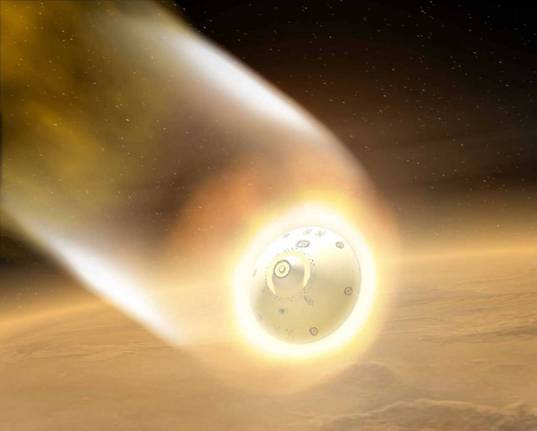
NASA / JPL-Caltech
Giving the gift of exploration since 2004
On January 24, 2004 Opportunity entered the top the Martian atmosphere right on schedule at 8:59 pm, Pacific Standard Time, traveling at 19,300 kilometers (about 12,000 miles) per hour. At 9:05 p.m., [5:05 January 25, 2004 UTC], her speed slowed by friction, a parachute, and retro rockets, "Little Miss Perfect" bounced onto the Martian ground in Meridiani Planum, landing with a relatively light impact force of between 2 and 3 Gs. "We're on Mars!" Entry, Descent & Landing Manager Rob Manning announced from Mission Control at JPL. You could almost hear the cheers coming from around the world...and Opportunity has been roving ever since.When November dawned at Endeavour, Opportunity was hunkered down over an outcrop named Private Ebenezer Tuttle ready to begin gleaning the chemical composition of the rock with her Alpha Particle X-ray Spectrometer (APXS). The plan was for the robot to wake up in flash so that the MER software engineers could begin emptying the drive of data collected in October. But the Deep Space Network (DSN) failed to transmit the commands, so the rover executed run-out plans instead on Sols 4184 and 4185 (October 31, 2015 and November 1, 2015).
The first week of the month was a tough one. On Sol 4186 (November 2, 2015), the MER ops team re-sent the commands to the rover to wake up in flash and begin returning Pancam images taken in October. Although those commands were successful, the rover immediately had a bout of amnesia and her flight software automatically switched her into RAM mode.
As contingency, just as Callas said in the October issue of the MER Update, the rover sent home more code from the flash’s drive’s bank 7. This is the bank to which the software engineers traced the amnesia and sudden reboot issues and the software engineers are in the process of reviewing all the code to make sure that bank was completely erased and masked.
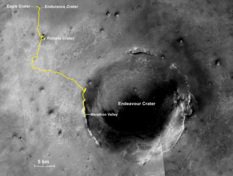
Oppy's long and winding road
The gold line on this image shows Opportunity's route from her Eagle Crater landing site to her approximate current location. Since August 2011, the MER mission has been exploring the western rim of Endeavour Crater. The rover entered Marathon Valley in July. The base image for the map is a mosaic of images taken by the Context Camera onboard the Mars Reconnaissance Orbiter. Larry Crumpler, of the New Mexico Museum of Natural History and Science, provided the route add-on.NASA /JPL-Caltech / MSSS / NMMNHS
On Sol 4187 (November 3, 2015), Opportunity mounted flash on wake-up and successfully uplinked some of the Pancam images stored in the drive to one of the orbiters and continued her chemical sleuthing on Pvt. Tuttle. But two sols later, the DSN was unable to transmit the rover’s Sol 4189 (November 5, 2015) bundle.
In addition to the DSN being "oversubscribed" with so many ongoing missions, the interplanetary communications system is implementing some new software to reduce cost and automate as much of the station operations as possible. “We're experiencing some of the bugs with that new software," said Callas.
That same sol Mars, Opportunity suffered a sudden reboot or warm reset. “And that killed the sequences and left the rover in automode with unknown high gain antenna (HGA) gimbal angles,” said Nelson. “On Sol 4190 (November 6, 2015), the unknown HGA gimbal angles caused an X-band fault when the rover attempted to configure the X-band radio for communication.”
The engineers expected this and sent recovery commands, which successfully reset the HGA fault. “Unfortunately, the recovery command to restart the sequence failed because it arrived a few minutes too late, leaving the rover in automode,” said Nelson. Commanding and caring for a rover on Mars isn’t easy, but on Sol 4191 (November 7, 2015) the rover was back in action, working on determining the chemistry of Pvt. Tuttle.
Opportunity’s technical challenges would continue though through the second week of the month. On Sol 4196 (November 13, 2015), the rover suffered another sudden reboot, but the MER ops team was able to restart the sequences the following sol. The DSN issues and even the sudden reboots weren't the worst of it in terms of work interrupted.
As the robot tried to use her flash, she was “plagued by amnesia events,” said Nelson. “We had probably 80% of our downlinks come up in amnesia.”
When Opportunity has amnesia, her flight software system automatically builds that sol’s file system in RAM. “So all this data we were trying to downlink was in an inaccessible area, because we were looking in RAM, and the data is held in flash memory,” Nelson explained.
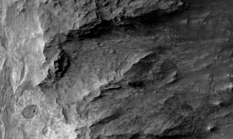
Overhead view of Marathon Valley
The HiRISE camera onboard MRO took this overhead image of Marathon Valley. The valley stretches west to east about 330 meters (1100 feet) into the 22-kilometer (13.7- mile) diameter Endeavour Crater (to the right). Opportunity is now working from a site on a steep slope up the valley's southern wall and roving into what is "looking like the most interesting and scientifically productive winter the mission has had in a long time," said MER Principal Investigator Steve Squyres.NASA / JPL-Caltech / UA
By way of analogy, Nelson continued: "Imagine you're going on a trip. You pack your suitcase the night before and put it back in your closet. The next morning you grab a suitcase and head to the airport, but when you get to your hotel and open your suitcase, it's empty. All the stuff you packed in the suitcase is there. It's just that you can't access it, because you grabbed the wrong suitcase. That's kind of like an amnesia event. The data is sitting there, but we can't access it in amnesia or RAM mode.”
Since Opportunity repeatedly experienced these bouts of amnesia, she wound up spending more time than initially planned on the task of emptying flash. Even at the end of the second week of November however, there were still data products stored in the rover’s long-term memory. "We got about 120 megabits of mostly Pancam science data during the two-week period we were in flash – and still have 178 megabits still stored there," said Nelson.
Interestingly, there seemed to be a correlation between time of day and when Opportunity was able to successfully wake-up and mount flash. For the most part, on the sols when the rover was able to uplink to the Mars Reconnaissance Orbiter (MRO), she was able to mount flash. Since the MRO relay comes over early in the afternoon, about 2 pm, the rover generally stayed awake until to the 2 pm relay. “On those links, we started getting stuff out of flash,” said Nelson.
But Opportunity’s UHF uplinks to MER’s usual Mars Odyssey passes predominantly came up in RAM mode. “About 80% of our UHF passes, mostly Odyssey passes, were in amnesia,” Nelson said. “While we built sequences for the rover that gave us data we could use [if the rover’s flight software defaulted to RAM mode], it wasn't data from flash, which was the primary goal.”
Still, it wasn’t that simple. The rover was able, Nelson noted, to successfully use flash when she woke up later in the afternoon and stayed awake until Mars Odyssey passes, which come by in the late afternoon, early evening.
And the MRO passes were not without issues. “We are relying on MRO more during the winter … its overflights happen earlier in the afternoon so we can nap afterwards until time for DeepSleep,” said Nelson said. But the MRO passes are usually to the west of the rover and thus at least partly occluded by the northwest wall of Marathon Valley. “Most of the MRO passes have been low elevation so some are only above the wall for 2 or 3 minutes instead of the 8 to 10 minutes of a typical pass,” he said. “Low elevation passes mean longer distances between orbiter and rover, and longer distances mean poorer link performance. So the combination of occluded passes and longer distances (what is called the ‘slant range’) lead to lower, sometimes much lower, link data volumes,” he explained.
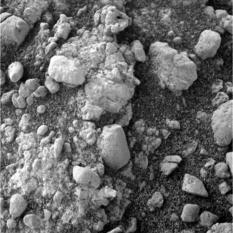
Pvt. Tuttle up close up
Opportunity used her Microscopic Imager (MI) in mid-November 2015 to take this raw image of a target the team named Pvt. Ebenezer Tuttle, after a member of the Lewis & Clark expedition. It was the last of four targets the robot field geologist checked out in the mission's first mini-science campaign after the rover drove into the southern part of Marathon Valley.NASA / JPL-Caltech
The MER mission still relies on Odyssey as its primary orbiter for the rover to send its UHF uplinks of data. However, since Odyssey’s orbit has been changed for better science, those overflights are late in the afternoon and even after sunset. So, as it stands right now, flash appears to be “not particularly useful,” Nelson said, unless the rover uses it with MRO. And, since MRO is the primary relay for Curiosity / Mars Science Laboratory, MER just doesn’t get as many MRO passes as they could use.
Having Opportunity work more in flash will perhaps reveal more, but it won’t happen until after the Martian winter eases, according to Callas.
The scientists weren’t terribly upset that Opportunity was unable to completely empty her flash drive. “There is some stuff still in there, but if we never saw it, I don’t think it would be a big deal,” said Squyres. “I'm not losing any sleep over the stuff that's still in flash.”
Nevertheless, the team is not giving up on flash and restoring at least some of the rover’s long-term memory. One of MER's engineers, Mehran Gangianpour, has been tasked with the job of going through the flight software to trace the dozens of pathways via which the rover could end up in RAM mode. "It's going to take him a while to track all this down, but that should, hopefully, tell us what the conditions are when we go into amnesia, and maybe we can instrument things and/or troubleshoot more,” said Nelson.
There is also talk of reformatting flash, again. "Maybe that will rejuvenate it and fix some of these amnesia problems," Nelson said. “While the amnesia events were 'killing' us this past month, we only had two warm resets, both of which were flash related,” he noted. That is imminently livable. If we could get out of this amnesia mode, we'd be in flash all the time.”
As the third week of November got underway, Opportunity returned to operating in RAM mode and finished her investigation into Pvt. Tuttle. On Sol 4200 (November 17, 2015) the robot field geologist roved 12.79 meters (41.96 feet) up the valley’s south wall to her current location, an area named for Private Isaac White of the Lewis & Clark expedition.
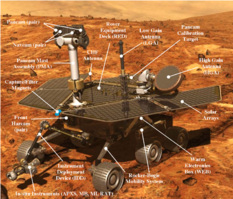
A sum greater than her parts
Opportunity's parts are similar to what any living creature would need to keep it "alive" and able to explore on Mars. The veteran Mars Exploration Rover has made use of her parts beyond all imagination, roving and exploring 11 years and 7 months longer than the original 90-day planned excursion.NASA / JPL-Caltech
The images Opportunity sent home showed that her drive – which put the rover’s odometer at 42,633.34 meters (42.63 kilometers / 26.49 miles) – was textbook MER. “We looked at the results of drive and we were right where we want to be, said Arvidson. Angled at about 20 degrees toward the Sun in the northern sky, the rover’s position on the steep slope was within reach of “normal looking outcrop rocks and red zone rocks on the wall," outcrop that could be examined and compared, he said.
"The interesting question is how do the red bands differ chemically from the background bedrock. What has happened?" said Squyres. "We suspect that these are places where water has interacted with the rocks and caused alterations to the clay minerals and has also resulted in the changing color.”
“I think the [red zones] are alteration zones of preexisting outcrops, likely fracture-controlled,” posited Arvidson.
This investigation has presented the scientists with “an interesting challenge,” as Squyres put it. “Everywhere the rover has found these deep red zones, the rocks have been “real cruddy and crumbly,” said Squyres. “I think the reason for that – and this is speculation now – is that the same alteration process that produces the deep red color that we think [may be] the phyllosilicates is weathering. It makes this stuff crumbly. So everyplace we've been working so far down on the valley floor, this crumbly, cruddy stuff is invariably mixed with soils, stuff blown in from somewhere. We're trying to tease out these subtle geochemical differences, but the measurements are very hard to make because there's all this dirt mixed in with it."
On the steep slope where Opportunity is now, she will not only dramatically boost her power but, the scientists believe, will find outcrops that are less likely to be covered with crumbly stuff, “because crumbly stuff will more easily tumble downhill,” said Squyres. “We think it will be easier to get cleaner surfaces of both the red stuff and the non-red stuff, the weathered stuff and the background stuff up on these steep slopes. That is going to be the goal for the coming winter months,” he said.
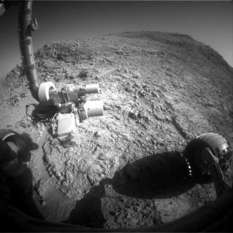
Working Pvt. White
Opportunity took this image of the Pvt. White site in late November with her front Hazard Camera (Hazcam). The robot had just repositioned herself to begin checking out chosen targets up close with the instruments on her robotic arm or Instrument Deployment Device.NASA / JPL-Caltech
Opportunity retracted her Instrument Deployment Device (IDD) on Sol 4202 (November 19, 2015) to get it out of the view of the Pancam. That weekend, the robot took color images of Pvt. White of the workplane with the Pancam, “so we could choose the juicy spots on which to put the IDD down over the weekend," said Arvidson.
Although most Americans took off much of the last week in November to celebrate and relax over the Thanksgiving holiday, the robot, as usual, didn’t get the holiday off. In addition to the usual routine business of checking on the atmospheric opacity and taking navigation camera (Navcam) pictures, Opportunity took Pancam images of targets on the Pvt. White outcrop, including Private Richard Windsor on Sol 4209 (November 26, 2015) and Private Hugh McNeal on Sol 4211 (November 28, 2015), a target the robot also looked at up close with Microscopic Imager (MI) and later with her APXS to determine its chemical make-up.
And then, on the final sol of the month, Opportunity used her 4,213th day on Mars to bask in the sunlight at Pvt. White and recharge.
All in all, right now, life on Mars is good. "We have seen our dust factor actually slowly increase, so it looks like we've been getting a little bit of dust cleaning everyday. Our power levels have been above the predicts and we're really pleased with the way the rover is handling,” said Nelson.
Opportunity began November producing around 344 watt-hours with an atmospheric opacity or Tau of 0.472, a solar array dust factor of 0.574, and total odometry of 42.62 kilometers (26.48 miles). The rover didn’t wrack up much mileage in November – at month's end her odometer read 42.63 kilometers (about 26.49 miles). But importantly, she was producing 381 watt-hours of energy as a result of her tilted position. The skies overhead had cleared a bit more and the Tau was hovering around 0.456, and the rover’s dust factor eked up to 0.618.
Although it appears Mars is going “cooperate” by offering up a light winter this time around, the team is ever vigilant. On Mars, as on Earth, you just never know what might happen and Martian winters can be deadly cold to robots.
The temperatures at Endeavour have now dropped to “cold enough” that when the rover defaults into automode or into run-out sequences, or when the flight software controls wake-ups and shutdowns, Opportunity is not awake long enough to keep the REM [rover electronics module] warm, Nelson said. “If that would continue for a couple of days, the REM temperature can drop low enough that the REM heaters would turn on.”
Since those heaters, the rover's so-called survival heaters designed to keep the REM from freezing, draw a lot of power, it’s not what the engineers want happening. The solution is simple in theory: Opportunity has to stay awake more.
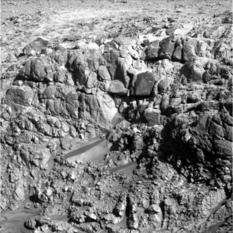
Another view of Pvt. White site
Opportunity took this raw image of the Pvt. White outcrop with her Pancam while most Americans were celebrating Thanksgiving Day. The dark streak in middle lower is likely basaltic sand, informed MER Deputy PI Ray Arvidson. You cannot see the so-called red zones in this monochromatic image and the Pvt. McNeal target the scientists may 'dig' into, is just below the bottom and thus not in the frame.NASA / JPL-Caltech / Cornell / ASU
To avoid any chance of the REM heaters turning on, the MER engineers have added communications windows, Low Gain Antenna (LGA) X-band receiver sessions. “Because they are comm windows, they will be honored whether rover is in sequence or not,” Nelson said. Basically, these sessions wake rover up and rover listens for uplink. “We don't care if there is no uplink. Their purpose is to keep us awake and the REM warm not to actually transfer data,” he said. (Of course, they could also be used to transfer data.)
So, while the rover’s power levels are good, especially with Opportunity’s current tilt on the steep slope of Marathon Valley’s south wall, “it's not overly robust," said Nelson. “We don't have power to burn, and so we've been careful not to overuse rover energy.”
The MER ops team does have some experience with Martian winters and everyone, engineers and scientists alike, are working together, like the well-oiled machine they became years ago. As Opportunity and the team head into their seventh harsh season and toward the mission’s 12th anniversary, coming up in January 2016, the prospects for the rover to keep on roving are as good as they could be.
"The vehicle is pretty clean right now and that's good,” said Squyres. “But the fundamental reason I think we'll be able to keep going all winter is because the topography here is just ideal. We've got this beautiful, long, east-west running ridge with some very steep terrain, some of the steepest terrain we've been on with Opportunity in years … broad swaths of terrain that have acceptable tilts on them. It sort of reminds me of the first winter we spent with Spirit where we were on the north slope of Husband Hill and everywhere we went was pointed north,” he reflected. “Some places were better than others and that's when we got into ‘lily pad’ [north-facing slope] mapping and we're doing ‘lily pad’ maps here as well.”
"We should be fine this winter," Herman concurred. “We're so much cleaner than we have been in past winters. Not having all that dust on the arrays has been really helpful because we have had some of the terrain in Marathon Valley [the north wall in particular] block some of the sunlight, so having cleaner panels compensates for that. If the scientists want the rover to move, I have recommended that they keep a northerly tilt of 10 degrees or more. That will give them enough energy to do what they need to do.”
Opportunity’s winter science campaign is set. "We're going to do the 'Electric Slide,’” as Arvidson put it at one of the EOS meetings before Thanksgiving. “You know, like at weddings where at the end the disc jockey plays “Electric Boogie” and people, usually women, do this line dance called the Electric Slide?”
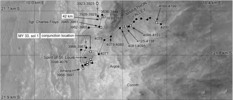
Recent roves
This map of Opportunity's recent rovings and science stops was produced by Phil Stooke, an associate professor at the University of Western Ontario in Canada, author of The International Atlas of Mars Exploration Vol. 2, Spirit to Curiosity: 2004 to 2014and an active member of Unmanned Space Flight.com. The base image was taken by the HiRISE camera onboard MRO.NASA / JPL-Caltech / UA / P. Stooke
The Electric Slide concept was pretty much lost on both the science team and the engineering team. "The Electric Slide idea went over like a lead balloon with the science team, because I don’t think that any of them dance, except Barbara Cohen," lamented Arvidson. Cohen leads the planetary science group at the Marshall Space Flight Center and is a member of the MER science team.
"It was kind of lost on the engineers too," Herman said. "I wasn't in that EOS meeting, but Ed Guiness [senior research scientist at WUSTL and a member of the MER team], told us about it in the engineering meeting. We all just kind of looked at each other. Ed said, 'You guys know the dance, right?' It was like crickets on the other end.”
Arvidson sent an email off to the team with the link to the YouTube of the Marcia Griffith's disco hit, first released in 1983 at the height of the disco era, and then again in 1990 when it reach 51 on Billboard's Hot 100. [Dig the spandex and poofy pants… hey, 2015 has nothing on 1983.] As Arvidson tried to inform the team, it is indeed a celebratory staple, popular in the U.S., at weddings, bar and bat mitzvahs, and other special occasions.
"The idea is that we do this ‘slide,’ working our way along this north-facing slope on the southern wall," said Squyres, who does know of the Electric Slide. “Obviously, sliding is not what we're going to do. We don't want to slide but drive along the slope and maintaining a northward tilt all through winter.”
“In my opinion, the scientists can do all the ‘sliding’ they want this winter, as long as they keep it pointing 10 degrees north!” joked Herman.
With the slopes, the fractured and layered outcrops of dramatic shades of Martian red before them, the MER scientists are as excited now as they were when Opportunity opened her eyes after landing in 2004. Well, almost. Seeing bedrock on Mars that first time is the best of memories that likely stands alone for many of the team scientists. Still, the rover is nearly 12 years old now and the evidence of clay minerals and near neutral past water are here for the taking.
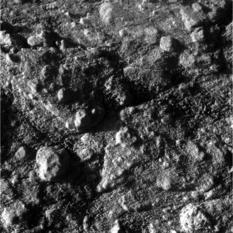
Pvt. McNeal up-close
On her Sol 4211 (Nov. 28, 2015), Opportunity used her MI to take this raw, close-up image of Pvt. Hugh McNeal at the Pvt. White site. As November turned to December, the MER scientists were considering having the robot brush, maybe even grind into this target with the Rock Abrasion Tool (RAT). Stay tuned.NASA / JPL-Caltech
Opportunity has her winter science campaign cut out for her. “We have lots to do at the current site and will probably be at Pvt. White for weeks and then ‘slide’ laterally probably for the next six months," said Arvidson. "As we get closer, we’ll be able to pick it out and understand the stratigraphy, the layers as opposed to the structure, and determine whether the red rocks are carrying the smectite signature we see from orbit.”
When Opportunity first arrived at Marathon Valley, the scientists didn't realize the red banding or red zones existed. "We didn't know it was there,” Squyres said. “Once we came to realize it, we had to do a systematic job of mapping this stuff and we can only do it with color Pancam. It takes a while and we're working our way through it. So it's not like there was one – boom! – moment of discovery. Rather it's been a gradual realization that, yes, there's a strong, strong correlation here that must be related to phyllosilicate story. Now the question becomes: what is the specific carrier of that phyllosilicate signature that is in the red bands?” he said.
By climbing up the hill and really taking the time to find “the reddest red and the non-reddest non-red target,” the MER scientists think they will be able to isolate the clay carrier(s), Squyres said. “We're open to using the RAT here, a brush, maybe even a grind to really get at the details of the stuff that is not altered. Then the idea will be to find the bedrockiest-looking red stuff we can find.,” he said. “With that, we should be able to do a comparison between the two that should lead readily to an understanding of the geochemical differences between the two.”
Roving forward, Opportunity will work in RAM mode likely through the Martian winter, saving each sol‘s data in her volatile random access memory and then sending it home that same sol before she goes to sleep. “That works fine for us and we're doing our thing,” Squyres said. “It doesn't throttle the downlink that comes down to Earth, because we're always limited by how much downlink we have.”
It does, however, restrict the sols on which the rover can take a lot of Pancam images to sols when the mission has a large DSN downlink. “But that translates into an activity scheduling issue. In terms of getting our science done, there's nothing that we can't do in RAM mode," Squyres summed up.
Despite the amnesic false starts and accompanying frustration in trying to empty out the stored data in flash in November, the science team couldn’t be happier. "We really are at a treasure trove of geological information at this new site," said Arvidson.
"This is to me looking like the most interesting and scientifically productive winter the mission has had in a long time,” said Squyres. “The driving is more interesting and challenging, the views are better, and I'm feeling particularly upbeat about the way things are going right now. This is a just a perfect winter situation for us.”
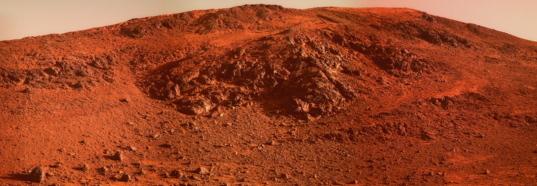
NASA / JPL-Caltech / Cornell / ASU / S. Atkinson
Get ready for The Electric Slide
In coming weeks and months, Opportunity will rover along the southern wall of Marathon Valley on her winter science campaign, doing something akin to "The Electric Slide," as MER Deputy PI Ray Arvidson described it. He was referring to the Marcia Griffith's disco hit, first released in 1983 at the height of the disco era, and now a celebratory staple, in the U.S. Though the concept was lost on most all the scientists and engineers, Jennifer Herman, MER's power team lead, chuckled: "In my opinion, the scientists can do all the 'sliding' they want this winter, as long as they keep [the rover] pointing 10 degrees north!" Stuart Atkinson processed this view in Martian 'technicolor.'Support our core enterprises
Your support powers our mission to explore worlds, find life, and defend Earth. You make all the difference when you make a gift. Give today!
Donate

 Explore Worlds
Explore Worlds Find Life
Find Life Defend Earth
Defend Earth


